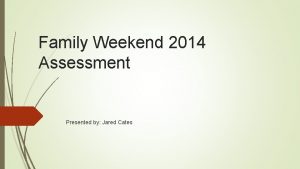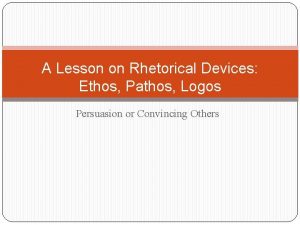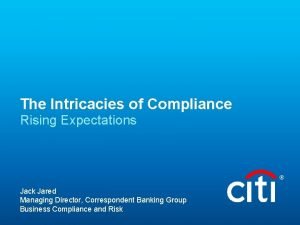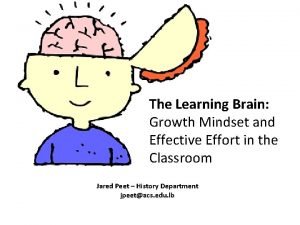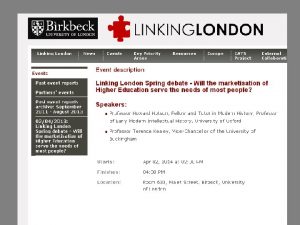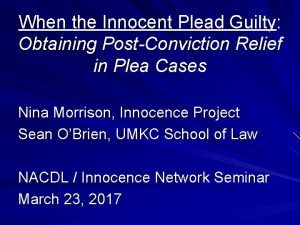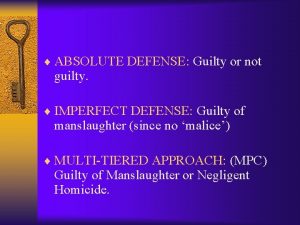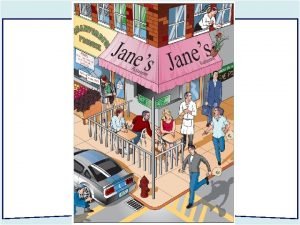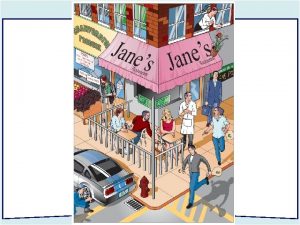PSYCHOLOGY AND CRIME Meet Jared Laughner Plead guilty

















































- Slides: 49

PSYCHOLOGY AND CRIME

Meet Jared Laughner • Plead guilty to 19 charges including murder and attempted murder, including his target, Rep. Gabrielle Giffords • Showed strange behavior 2 -3 years prior, including more and more alcohol and drug use • Suspended from Pima Community College • Finally diagnosed with paranoid schizophrenia

KENNETH BIANCHI, A. K. A. "THE HILLSIDE STRANGLER" (PLED GUILTY, 1983) IN 1977 AND 1978, KENNETH BIANCHI AND HIS COUSIN ANTHONY BUONO WENT ON A MURDER SPREE, RAPING AND KILLING 10 GIRLS AND WOMEN AND LEAVING THEIR BODIES IN THE HILLS OUTSIDE LOS ANGELES. AFTER THE 10 TH MURDER, BIANCHI MOVED TO BELLINGHAM, WASH. , WHERE HE RAPED AND KILLED TWO MORE WOMEN -- A COWORKER AND HER FRIEND, WHOM HE LURED TO A SECLUDED HOUSE. AFTER HIS ARREST, HE CONFESSED TO ALL THE MURDERS. WHILE IN CUSTODY, BIANCHI FEIGNED MENTAL ILLNESS, IN THE HOPES OF RAISING AN INSANITY DEFENSE. HE CLAIMED TO HAVE MULTIPLE-PERSONALITY DISORDER, AND THAT HE HAD NO MEMORY OF THE MURDERS BECAUSE THEY WERE COMMITTED BY ONE OF HIS "ALTERS. " EXTENSIVE EXAMINATION UNDER HYPNOSIS, HOWEVER, PRODUCED STRONG EVIDENCE THAT HE WAS FAKING. FORENSIC PSYCHIATRIST MARTIN ORNE CONCLUDED THAT BIANCHI'S STORIES OF THE ALTERNATE PERSONALITIES WERE INCONSISTENT WITH ONE ANOTHER, AND WITH OTHER REPORTED CASES OF MULTIPLE-PERSONALITY DISORDER. BIANCHI EVENTUALLY WITHDREW THE INSANITY CLAIM AND PLED GUILTY OF THE WASHINGTON MURDERS, AGREEING TO TESTIFY AGAINST HIS COUSIN IN EXCHANGE FOR AVOIDING THE DEATH PENALTY IN THE LOS ANGELES CASE. THE LOS ANGELES TRIAL BEGAN IN 1981 AND STRETCHED ON FOR TWO YEARS. BIANCHI PLED GUILTY TO FIVE OF THE CALIFORNIA MURDERS; BUONO WAS CONVICTED OF NINE OF THE 10. BIANCHI IS SERVING A LIFE SENTENCE IN WASHINGTON; BUONO DIED IN PRISON IN CALIFORNIA IN SEPTEMBER 2002.

JEFFREY DAHMER (CONVICTED, 1992) IN 1991, JEFFREY DAHMER WAS CONVICTED OF THE MURDER OF 15 YOUNG MEN, WHOSE MUTILATED, CANNIBALIZED BODIES HAD BEEN FOUND IN HIS MILWAUKEE APARTMENT. DAHMER REPORTEDLY HAD SEX WITH THE CORPSES OF SOME OF HIS VICTIMS, ATTEMPTED TO PERFORM CRUDE LOBOTOMIES ON OTHERS WHILE THEY WERE STILL ALIVE, AND STORED BODY PARTS IN HIS REFRIGERATOR TO BE EATEN LATER. AT TRIAL, HE ADMITTED THE KILLINGS, BUT PLED NOT GUILTY BY REASON OF INSANITY. HIS PLEA WAS REJECTED, AND THE JURY FOUND DAHMER TO BE LEGALLY SANE AT THE TIME OF THE MURDERS. HE WAS SENTENCED TO 15 CONSECUTIVE LIFE SENTENCES WITHOUT CHANCE OF PAROLE. THE DAHMER CONVICTION WAS HAILED BY MANY AS THE DEATH OF THE INSANITY DEFENSE, AND A COUNTERPOINT TO THE HINCKLEY ACQUITTAL. IF SUCH A CLEARLY DERANGED KILLER COULD NOT BE FOUND LEGALLY INSANE, IT SEEMED UNLIKELY THAT THE DEFENSE WOULD EVER BE SUCCESSFUL, AT LEAST IN A HIGH PROFILE CASE INVOLVING A VIOLENT CRIME. DAHMER WAS KILLED IN PRISON BY ANOTHER INMATE IN 1994.

Osama bin Laden, the infamous mass murderer who changed the world with his catastrophic terrorist act on U. S. soil, has been described as half-mad, half-genius, evil incarnate and a narcissistic sociopath. Now that he is dead many wonder if he should have been brought to trial rather than captured and killed. Whatever the outcome of such a trial would have been, many in the media have already labeled bin Laden as criminally insane.

AREAS OF PSYCHOLOGY • Personality and crime • Abnormal Psychology and Crime • MMPI and the CPI • Antisocial Personality Disorder • Mental illness and Schizophrenia • Intelligence and crime • Learning disabilities

PSYCHOLOGICAL THEORIES (CON. ) • Attention deficit Disorder • Learning theory and crime • Moral development

PERSONALITY AND CRIME • Is there a criminal personality? • Personality: characteristics of an individual that predisposes one to act in certain ways in certain situations • Way one perceives, thinks about and relates to oneself and one’s environment

FREUD AND CRIME • Freud the first to write about personality • Believed that behavior is influenced by unresolved conflicts in childhood • Superego • Ego • Id


FREUD (CONTINUED) • Crime would occur if: • Malfunctioning of the id (too much) • Weak ego • Underdeveloped superego (no conscience) • Or, overdeveloped superego (desire to be caught and punished)

FREUD (CONTINUED) • Contributions of Freud • Behavior is influenced by psychological processes, some of them unconscious • Early childhood experiences are important • Behavior can be treated by psychological means

FREUD (CONTINUED) • Criticisms • 1. cannot be disproven • 2. focuses on internal factors, excludes societal factors • 3. focuses on treatment rather than prevention

PERSONALITY TESTS & CRIMINALITY • A variety of personality tests have been given to prison inmates • Generally do not provide a consistent pattern, one “personality • California Psychological Inventory: they tend to score lower on Socialization and Conformity • Lower on empathy scales

COMMON TRAITS • Hyperactivity • Impulsivity • Aggression • Sensation seeking/risk taking • Extroversion • External locus of control • Inability to delay gratification

PSYCHOLOGICAL TESTS • Minnesota Multiphasic Personality Inventory • 550 item T-F screening device for psychiatric problems • Given to thousands of prisoners • No single pattern emerges

TESTS (CONTINUED) • Indicates more psychological problems than in the general population, i. e. , Hypochondriasis, Depression, etc. • Most common pattern is that of the antisocial personality disorder (APD), with high scores on scale 4 (psychopathy) and 9 (mania)

ANTISOCIAL PERSONALITY DISORDER • Formerly known as psychopaths or sociopaths • Also conduct disorder (adolescents) • APD estimated at 3% in the general population, 20 -25% of incarcerated prisoners

CHARACTERISTICS OF APD • Failure to conform to social norms • Lie/cheat/steal • Exploit and manipulate others, use people • Lack of remorse • Absence of anxiety • Self-centered

APD (CONTINUED) • Reckless • Impulsive • Aggressive • Superficially charming • Inconsistent work history • Financial irresponsibility • Irresponsible parenting

APD (CONTINUED) • Sexually promiscuous • Poor judgment • Do not profit from past experience • Punishment is not effective • Causes unknown • Physiological basis? • Environment?

MENTAL ILLNESS: SCHIZOPHRENIA • Thought disturbance • “flat” affect • Ambivalence • Autism (withdraw from others) • Unusual behavior • Episodes of psychosis (not in touch with reality: delusions and hallucinations

MENTAL ILLNESS (CONTINUED) • Strikes 1% of the general population • More common in prisons • Most mentally ill individuals are not criminals • Most offenders are not mentally ill • However, there are some notable exceptions

SCHIZOPHRENIA (CONT. ) • Sirhan • Charles Manson • David Berkowitz: Son of Sam • John Hinckley • Jeffrey Dahmer

INTELLIGENCE AND CRIMINALITY • Intelligence: capacity to act purposefully, think rationally and deal effectively with the environment • Culture-bound concept: skills necessary for success in a culture • Lombroso hypothesized that his criminals were “feebleminded”, but there were no measure of intelligence

INTELLIGENCE (CONT. ) • Binet: first intelligence test • Used the concept of mental age: if the majority of children of a given age can complete a task, the task requires that mental age • He tested children, compared mental age to chronological age

INTELLIGENCE (CONT. ) • Goddard used his tests on institutionalized populations such as prisoners in the early 20 th century • Concluded that most prisoners were “feebleminded” • However, when the tests were tried in screening men for the draft in W. W. I, they came out feebleminded, too!

INTELLIGENCE (CONT) • Problem: MA does not change after mid-adolescence but chronological age does. Thus, using Binet’s test, everyone would become feebleminded • Goddard’s work was discredited • It was until the 1970 s that the issue of intelligence and crime was reconsidered by criminologists

DISTRIBUTION OF INTELLIGENCE

FINDINGS • 10 -15 point gap between offenders and non-offenders: 100 v. 87 • Better than 10% of prisoners are MR, while the percentage in the general population is less than 3% • Is this because of social class differences between prisoners and the general population? (SES affects IQ scores)

INTELLIGENCE (CONT. ) • Studies of nondelinquent and delinquent adolescents matched for age, social class and ethnic groups also find an IQ difference, although not as large • Lower IQ scores are associated with higher recidivism among offenders • Most of the differences are for Verbal IQ rather than Performance IQ

INTELLIGENCE • Higher IQ, especially verbal, might mean that one understands consequences better and have better planning skills--protective factor • A lower verbal IQ might mean that the person is less likely to use “internal speech” and be more impulsive (and thus less likely to be deterred)

EXPLANATIONS • The brighter might get arrested less often (although self-report studies still support a difference) • Higher verbal IQ is associated with better moral reasoning skills

EXPLANATIONS School problems hypothesis: Low verbal IQ -- poor academic achievement -- frustration -truancy and dropping out -- association with other dropouts, unemployment -- crime

LEARNING DISABILITIES AND CRIME • LD: academic achievement is not commensurate with IQ • Most common: reading problems • More common among males • Causes not clear--brain dysfunction? Problems at birth? Inherited? • More common among delinquents: 12% vs. 33%

ADHD • Attention-deficit hyperactivity disorder • Attention deficit • Hyperactivity • Impulsivity and aggression • More common among criminals than in the general population • More common among males (6 -10 x)

ADHD • Associated, although not exclusively, with low birth weight (5 lbs. or less) and/or prenatal malnutrition • Although ADHD gets better with age, 50% show residual signs in adulthood • 25% of APD had an ADHD diagnosis in childhood

EXPLANATIONS: LD & ADHD • Both tend to have more behavioral problems. Whether such problems are part of the disorders or a result of them, they are more at risk for behavior problems. • School hypothesis

LEARNING THEORY & CRIME • Learning a relatively permanent change, due to experience, that can affect behavior • Human behavior is learned, and learned by: • classical conditioning • operant conditioning • Observational learning

LEARNING • Criminal behavior can be attributed to faulty learning • Learned an inappropriate response • Never had the opportunity to learn an appropriate response

CLASSICAL CONDITIONING • UCS-----UCR • Food-----salivation • CS------CR • Bell (after paired with food) --salivation • Punishment----pain, anxiety • Illegal behavior-----anxiety

CLASSICAL CONDITIONING • Classically conditioned anxiety results in avoidance conditioning • Hypothesis: APD lack anxiety because their ability to develop classically conditioned responses is impaired

OPERANT CONDITIONING • Learning involves consequences to responses • Responses resulting in favorable consequences become more likely • Responses resulting in unfavorable consequences become less likely

OPERANT COND (CONT) • Reinforcement: strengths response • Positive reinforcement: receive “reward” increases p of behavior • Negative reinforcement: remove a punishment when a response is made, will also increase the p of that response • Positive punishment: aversive, unpleasant, decreases p of behavior

OPERANT (CONT. ) • Negative punishment: take away reward, remove positive • Generalization and discrimination • Schedules of reinforcement and extinction • Reinforcement, not punishment, is the way most behaviors are learned • Most powerful: love and approval

PUNISHMENT • An aversive stimulus that decreases the p of the behavior that precedes it • Factors affecting punishment • Immediate • Intense enough, but not excessive (excessive results in anger) • Consistent

PUNISHMENT (CONT) • Aimed at the misbehavior, not the person • Must provide positive reinforcement for alternative behaviors • Is the CJS going to be effective at punishing?

KOHLBERG & MORAL DEVELOPMENT • Developmental stages of moral development • Preconventional: moral reasoning in terms of reward and punishment • Conventional: moral reasoning in terms of following rules

MORAL REASONING (CONT) • Postconventional: moral reasoning in terms of what is best for the majority, or determining which ethical principle is most important • Delinquents and criminals: Commonly at the preconventional level, some at the conventional level, few at the postconventional level
 Jeffrey dahmer iq
Jeffrey dahmer iq Till we meet at jesus feet
Till we meet at jesus feet The guilty vicarage
The guilty vicarage Henry rathbone and clara harris
Henry rathbone and clara harris Remembrance emily bronte poem
Remembrance emily bronte poem Themes in macbeth
Themes in macbeth First body paragraph transition words argumentative essay
First body paragraph transition words argumentative essay Is steve guilty
Is steve guilty Guilty before god
Guilty before god No power of hell no scheme of man verse
No power of hell no scheme of man verse Criminal psychologist definition
Criminal psychologist definition Jared hoberock
Jared hoberock Who is the cat
Who is the cat Jared cates
Jared cates Jared frick
Jared frick Who is he
Who is he Jared chandler
Jared chandler Ap stats frq 2016
Ap stats frq 2016 Mahonri moriancumer
Mahonri moriancumer Jared o
Jared o Camp ramaquois 2019
Camp ramaquois 2019 Jared fogul
Jared fogul Jack jared
Jack jared Jared drach
Jared drach Edina alpine ski team
Edina alpine ski team Jared mason diamond
Jared mason diamond Jared mesa az
Jared mesa az Outaging
Outaging Jared luffman
Jared luffman Jared filseth
Jared filseth Jared hoberock
Jared hoberock Hear us from heaven jared anderson
Hear us from heaven jared anderson You can always substantially change how intelligent you are
You can always substantially change how intelligent you are Jared gustafson
Jared gustafson Jared investigated chemical reactions
Jared investigated chemical reactions Ethnocentrism examples
Ethnocentrism examples Jared guyer
Jared guyer Garden path sentence explanation
Garden path sentence explanation Cerinthianism
Cerinthianism Positive psychology ap psychology definition
Positive psychology ap psychology definition Psychology chapter 13
Psychology chapter 13 Fundamental attribution error ap psychology
Fundamental attribution error ap psychology Explain methods of psychology
Explain methods of psychology Social psychology definition psychology
Social psychology definition psychology Health psychology definition ap psychology
Health psychology definition ap psychology Meet and greet agenda
Meet and greet agenda I can’t find _____. does _____ steal it?
I can’t find _____. does _____ steal it? Examples of charging by contact
Examples of charging by contact Find market n
Find market n Area of low pressure where air masses meet and rise
Area of low pressure where air masses meet and rise













